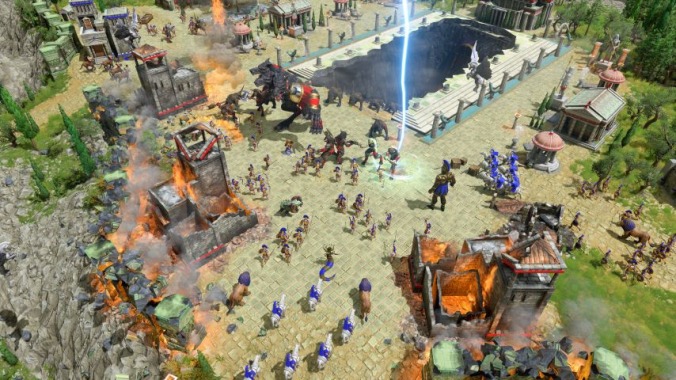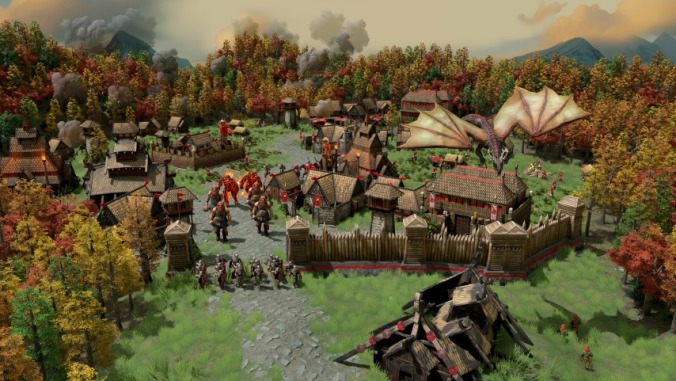Even Real-Time Strategy First-Timers Will Enjoy Age of Mythology: Retold

It’s been 22 years since Ensemble Studios released Age of Mythology, a spin-off to the popular Age of Empires series. The landscape surrounding games—and specifically the real-time strategy genre—has changed greatly in that time, in large part thanks to the dawn of esports. Just this month StarCraft II was an event at the inaugural Esports World Cup, offering a $1 million prize pool. Age of Mythology: Retold, the 2024 remake/remaster from co-developers World’s Edge and Forgotten Empires, aims to bring the title forward in time and earn a place in the competitive esports world, but also provide quality of life updates that can attract a whole new audience. I, as fate would have it, am part of that audience. Prior to picking up Age of Mythology: Retold, I’d never played a real-time strategy game. People who review games are not perfect machines—everybody has their blind spots, whether those are specific franchises or whole genres. For example, I’ve written a review and essay for two different Metroid-style games for Paste, and have never played the genre’s namesake. This lack of expertise should be acknowledged and disclaimed; it also gives the unique opportunity to provide a review for others like myself who are new to the real-time strategy genre.
Age of Mythology: Retold tasks the player with leading a civilization to conquest. Conceptually, it’s not so different from Riskopoly (a medley of the board games Risk and Monopoly—for true sickos only) where economic and militaristic management are key. Villagers can be instructed to gather resources, those can be exchanged for military units, and those can wage war for access to more resources. The moment-to-moment gameplay involves direct management of all units on the field: will your villagers gather food, gold, or lumber? Are you directing a portion of your army to guard them from enemy soldiers? How close are they to the nearest resource storehouse, and should you build one closer to them for faster gains? Uh oh, looks like you diverted too much of your army to protect your villagers and left your eastern flank vulnerable to an enemy ambush! Now you need to replenish your defeated military instead of building that ballista. This pushes back your siege plans, and puts you on the defensive. What should your villagers gather now?
This sounds like a lot to manage at once, and can appear overwhelming. Thankfully, Age of Mythology: Retold makes it incredibly easy to jump in as someone new to the genre. There’s an introductory tutorial, a suggestion to play a specific campaign first, and helpful advice continually given throughout the opening chapters. Villager resource priorities can be auto-assigned according to various game stages, and while this doesn’t seem like something high-level players will utilize, it gives a newer player more time to manage other aspects of their civilization. Most appreciated are the newer, easier difficulty options: players looking for the challenge they faced in 2002 can still find it here, but there are more forgiving options for players looking to dip their toes in.
Age of Mythology: Retold also runs incredibly well, which helps when your focus should be on numerous other things. Throughout my time with the game, there’s only one bug or glitch I encountered: occasionally a villager or army unit would get completely stuck in odd corners of terrain. This was never detrimental—you can delete them from the world with a single click, if need be, and they can be replaced rather quickly—except for when it happened to more valuable units. In one instance, Arkantos (the commanding unit for much of the game) became trapped between a shrine and a cliff face, and though this didn’t ruin my game, I sure missed having a powerful player on the field.

I want to specifically call out something that deserves applause: Age of Mythology: Retold launches with text-to-voice narration turned on by default. For players who wish not to use this feature, it can be turned off in a matter of seconds within the pre-main menu accessibility panel. I personally think this should be the standard. The Last of Us Part II has some of the most accessibility features I’ve seen in a game, bar none—they mean very little if a person that needs them can’t even navigate the menu to turn settings on. The recent Age of Empires releases have also had this on by default, and I hope it continues to trend. It absolutely falls in line with the idea of introducing the game to new audiences.
-

-

-

-

-

-

-

-

-

-

-

-

-

-

-

-

-

-

-

-

-

-

-

-

-

-

-

-

-

-

-

-

-

-

-

-

-

-

-

-









































